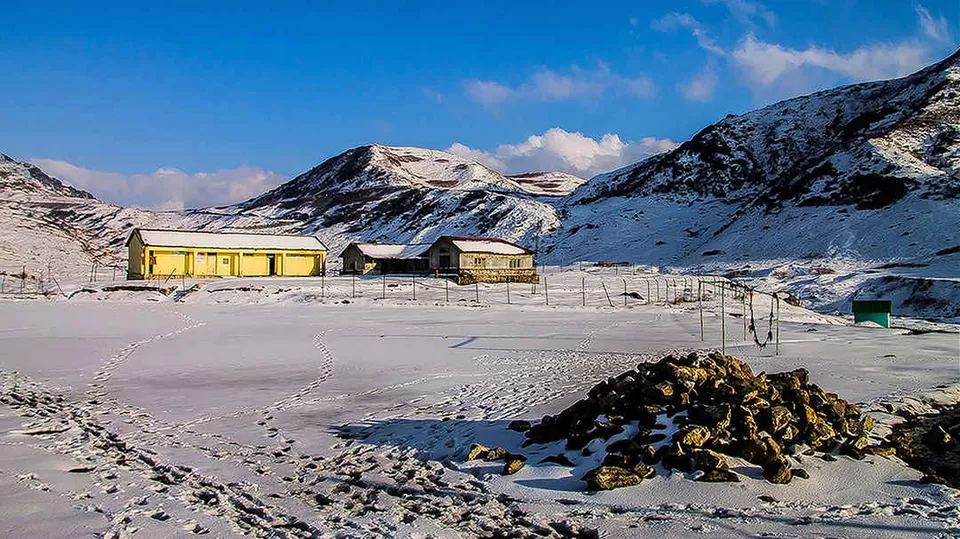
A domain of bliss, Nathang Valley, or Gnathang Valley as it is frequently spelled, is located at a whopping altitude of 13,500 feet above sea level. This valley is without a doubt, full with beautiful places, and because of its phenomena of naturally high altitude, it draws a lot of tourists every year. It is one of the highest regions in East Sikkim. Sometime in the past, Yak herders from Tibet called it their home. It is currently the most popular yet unconventional destination among travellers.
This valley is one of Sikkim's most noteworthy locations because it is included in the Silk Route Circuit.

Places to Visit :
1. Lungthung
At a height of 12,500 feet above sea level, Lungthung, also known as Dhupidhara, is a mountain that provides a beautiful view of Mt. Kanchenjungha. The Eastern Himalayas are close to Thambi View Point, which provides a bird's-eye view of the mountain. This area is favored primarily by bird enthusiasts and is home to the Monal, the national bird of Nepal. The summit will be covered in white snow from January to April, and from June to September, when flowers are in bloom, they will be bathed in bright colors.

2. Aritar Lake
The highest lake in East Sikkim, Lampokhari Lake, is located in a small village in the valley at a height of 4600 feet. It has boating facilities. This naturally occurring body of water, also known as Aritar Lake, is surrounded by a pine tree forest and has a little walkway built around it so that visitors may take pictures and enjoy the view. The region is surrounded by pine forests and a modest Guru Padmasambhava shrine, which draws greater interest from the tourists.

3. Changu Lake
Among the places described above and others, Changu Lake or Tsomgo Lake is the most well-known or frequently visited. This lake, which was naturally formed by a glacier melting, has an oval shape, is 1 km long, and has a density of 50 feet. The lake, which is revered by the Sikkimese people for changing hues with the seasons and remaining frozen throughout the winter, is a natural wonder. The state flower, rhododendrons, bloom in a picturesque display along the lake's edge in mid-May, marking the conclusion of the winter season.

4. Eagle's Nest Bunker
Everything in this area is situated at a higher elevation than 12000 feet, if we are talking about a valley. And so does this Indian Army bunker that has been abandoned and is placed such you can see the Eastern Himalayas in all directions without obstruction. Everything is clearly visible from this bunker, including the entire range of Mount Kanchenjungha, the far heights of the Tibetan plateau, China, Western Bhutan, the Plains of Bengal with settlements like Darjeeling, and the great Bramhaputra River.

5. Old Baba Mandir
A temple built as a samadhi in memory of the martyred soldier Baba Harbhajan Singh, who was stationed in the bunker during the terrible natural disaster that struck West Bengal and Sikkim in 1968, is located at a height of 4000 meters and receives fewer visitors because it requires climbing 50 stairs to get there.

The soldier's body went missing during the 1968 natural disaster, and on the fifth day of the search, he appeared in a buddy soldier's dream and expressed a wish to take samadhi in the same location, which is now known as the Old Baba Mandir.
Nevertheless, a new temple has been built adjacent to Changu Lake for the convenience of visitors.

6. Nathula Pass
When it comes to the highest motorable roads in the world, this one in India is the highest at roughly 4300 meters. The Chumbi valley of Tibet is easily noticeable from Nathula Pass, which serves as the entry point for the border between China and India. Numerous people go through this route each year to hear the waterfall's lyrical sounds as it cascades into Sikkim's waterways. This location's name is derived from two Tibetan words, "Nathu" and "La," which mean "Listening Ears" and "Pass," respectively. It offers a snow-covered mountain beneath the clear blue sky and the lengthy, winding roadways. Being at a high altitude, this location frequently experiences cold weather and is crowded with tourists in the summer.

In addition to the aforementioned features, this location has a lot to offer to explorers and enthusiasts. A sense of spiritual stability is brought to the mind after repeated hikes to reach a location from which it is challenging to stroll like Kupup Lake or Menmecho Lake, and visitors undoubtedly carry this stability with them.
Accomodation options:
We have fewer options for lodging the more remote a location is. There are numerous homestays and historic buildings that have been converted into hotels in this valley as well. These establishments provide excellent service and delicious, organic, and healthy meals.
When planning a vacation to such locations, reservations must be made in advance to ensure that we have lodging alternatives.

How to Reach?
Due to its location in a valley, it lacks both an airport and a railway station. There is only one road that leads here.
However, Bagdogra Airport and New Jalpaiguri Railway Station (NJP) are the closest airport and railway station, respectively, to this location. A cab may be rented from either of the two places to go the 170 kilometers to the valley in 6 hours.

Best Time to Visit:
A area that experiences significant snowfall and rain is best visited in the summer. The best time to experience the splendor of the valley is from April through June.

Monsoon season is best if you want to see the valley's stunning floral displays, though. But during the monsoon, there is a significant risk component because the roads are frequently closed by landslides and strong rain.

The wanderlust crowds to this location when the winter season begins in October and the area has its first snowfall to photograph the breathtaking splendor of the snow-covered mountains that overlook the Tibetan Plateau.
Again, from October to March, one needs to exercise caution because of the severe snowfall and road blockages.

There are few fragments of heaven on earth, and Nathang Valley is unquestionably one of them. The several seasons give this valley a variety of tints. When the grass dries up in the opposite direction of how it appears during the rainy season, it is all coated in golden hues in the autumn. In the winter, 5 feet of snow covers the entire area.
We get to enjoy all of these in one place throughout the year. You may visit this location at any time of the year, and you will be rewarded with some breathtakingly gorgeous vistas.
Which season or month are you going to travel to this valley in? Please let me know in the comments.
Ready to travel for free? Earn credits and redeem them on Tripoto’s weekend getaways, hotel stays and vacation packages.
For more such travel content follow me on Tripoto and on Instagram.

